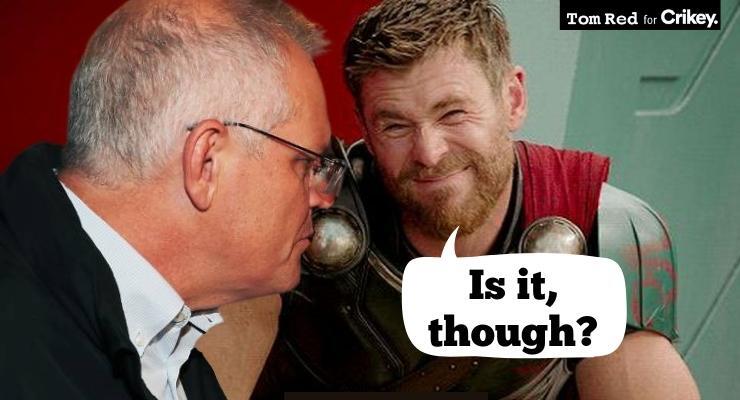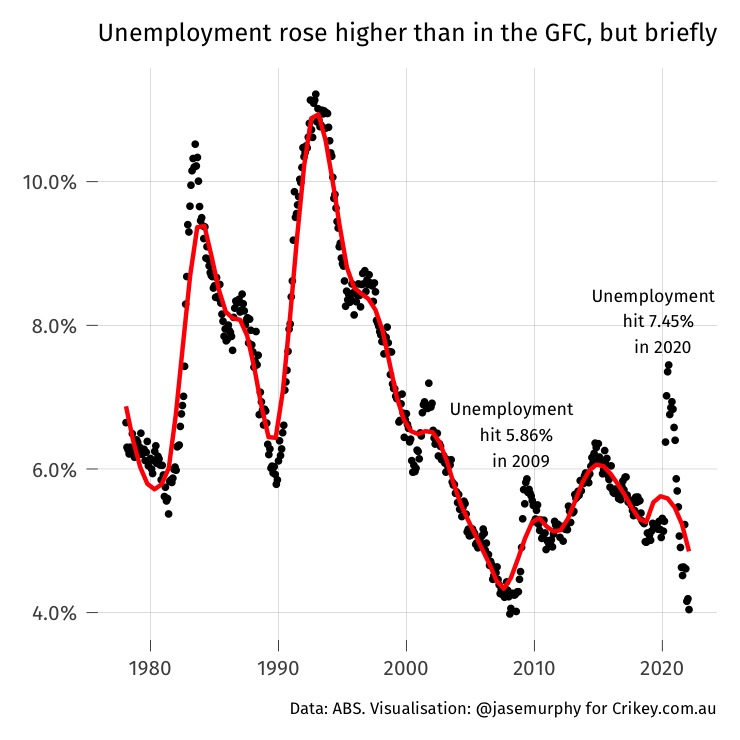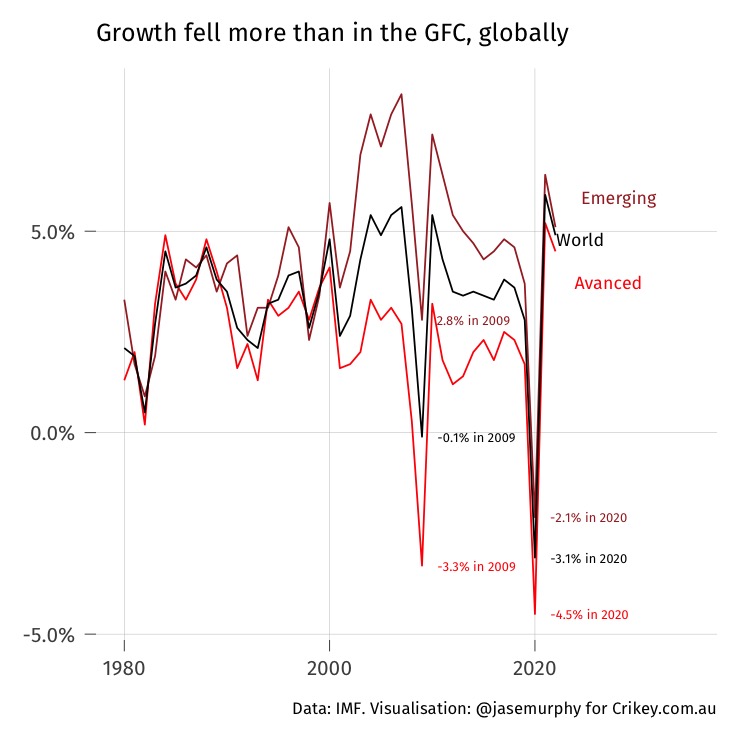
Wayne Swan once won World’s Best Treasurer. Apparently Scott Morrison seems to want to swipe it for his buddy Josh Frydenberg, having been out and about claiming the economic hit his government overcame was 30 times worse than that endured by Australia during the 2008-09 global financial crisis (GFC).
“You know, this global pandemic was 30 times worse economically than the global financial crisis of just over a decade ago. Thirty times worse. But our employment outcomes have been 50% better,” Morrison said recently.
We famously dodged a recession in the GFC, and we did not dodge one in the pandemic. Nobody doubts the pandemic was the more acute crisis.
But is Morrison’s claim true? Or is it another ScoMo special, a case of being loose with the facts?
So how can you manufacture the claim the economic hit from COVID was 30 times worse than the global financial crisis?
How about jobs?
Not by looking at unemployment. As the next graph shows, in the GFC unemployment rose from 4% to almost 6%. In the pandemic, unemployment rose from 5% to 7.5%. That’s slightly worse, no doubt. But is it 10 times worse? Nope.

How about growth?
The most generous comparison we can make is to compare Australia’s single worst quarter of the pandemic (April, May, June 2020) to the worst quarter of the GFC (October, November, December 2008). We can see a big difference, as the next chart shows. But it is not a 30-fold difference. More like a 14-fold difference, and only for the single worst moment. As the red line in the below chart shows, the recovery was quick.

Of course, if you do this analysis by year, not quarter, the size difference is smaller still. The pandemic had an extremely acute effect at the start of 2020 while the country was locked down and the world had no idea how bad things would get. We soon learnt ways of coping, including relying on online shopping to prop up consumption. GDP growth recovered. The GFC caused more lingering effects.
Aha!
Here’s what the PM was actually talking about: if you look at the IMF’s measure of world growth, it fell by 0.1% in 2009 and 3.1% in 2020. That is a 30 fold difference in those narrow terms. For advanced economies or emerging economies the comparison works out differently. The Prime Minister’s Office confirmed he was referring to the IMF data.

So is Morrison truthing for once? Well… if you check the World Bank’s data instead of the IMF’s you see a much worse story for 2009. They have growth falling by 1.4%, which means 2020 shows up as only twice as bad, not 30 times as bad.
It seems the PM is being selective. He’s not lying. But he has certainly found some facts that suit his narrative best.
The big picture
For us, looking at the above graph shows the whole picture, not just the part the PM might like us to look at. What we see is advanced economies have popped back to life in 2021 and 2022 — of course, we’re an advanced economy. This reveals the most important point. Which is that Morrison’s claim falls down not on the statistics but on the nature of the recession.
We don’t talk about this enough but financial crises are different to other kinds of recessions. They are far more damaging. This fact was brought to the forefront of economic thinking after the GFC, and explains why growth and wages growth in advanced countries have been so weak in the period between the GFC and pandemic.
“Financial crisis recessions are costlier, and more credit-intensive expansions tend to be followed by deeper recessions,” wrote University of California economics professor Òscar Jordà in an influential 2013 paper.
We bounced back from this recession quicker in part because of the enormous stimulus unleashed, but also because the recession was simpler: the virus made us hide inside. When vaccines came, the need to hide became much smaller. There were not big tears and twists in the underlying fabric of the economy that needed repair. Trust in the economy was not broken. The problem was biological.
This finding should not just make us scoff at ScoMo but also give us pause. The most recent recession was short because it was not about debt. But right now Australia is building up debt in very significant volumes, especially for owner-occupied housing. There’s $1.3 trillion on the mortgage books — a record. And rates are about to rise. The foundations may be being built for a longer and much more painful recession, even as Morrison boasts of his success.








As usual, the LNP trashes the joint for a decade or so, crapping all over the public interest as a matter of routine, causing problems of every scale. Then when Labor gets in, they’re faced with the LNP’s biggest crimes coming home to roost and have to spend like crazy to fix all the negligence.
It’s extraordinary how Coalition MPs regularly belittle Swan’s ‘world’s best treasurer’ title. It was a non-political award from an international, unaffiliated finance magazine. Coalition MPs throw the title at Swan as though it’s risible or shameful.
I note that none of the Howard/Abbott/Turnbull/Morrison brigade has received any international award, let alone an accolade for saving our economy.
As Fraser’s Treasurer, Li’l Johnny had the sobriquet ‘Honest John’ before he became the Rodent, surely that counts?
Unlike Leventy Smokin’ Joe or Fraudie.
Given you go by a Greek pseudonym, I’m surprised you didn’t get Labor’s use of irony in calling Howard ‘Honest John’…
I prefer to call Howard the ‘toad’. Alan Ramsey coined it, saying it was the only four letter word he could use in a family newspaper to describe him !
…whoooosh…
My preference for Howard is of course Liberal Senator George Brandis who coined .”The Rodent”
You must be forgetting Greg Hunt’s “World’s Best Minister” award in the UAE in 2016, for his success in reducing carbon emissions. Yup, that’s how the ABC reported it.
One of the keynote speakers was Yusuf Islam (aka Cat Stevens).
It seems that no-one could state exactly what were the objective criteria for the award.
But, hey “I ran in a race” is pretty important to the kids running.
Morrison’s claim is utterly meaningless and, consistently with all his claims, deliberately so. Its a 50% less fat claim; ie it cannot be proved or disproved. But he got you analysing Jason, and that was the only objective. Please, just ignore the idiot.
Please stop calling Morrison “ScoMo”. That’s his self anointed marketing name, designed to soften his image and to make him more appealing.
Thanks
… His self-indulgent pet name.
I think that nicknames should be appropriate and accurate,and so, as with “Honest John” aka “The Lying little rodent” there are the options of Smirko, SloMo and Scummo.
Smirko is my favourite.
ScoMo was a Crosby Textor invention to go with BoJo and both appear to be duds.
It just shows his marketting genius – slight letter change and it’s Scummo.
You’re being too kind 🙁
Apologies, I try not to be with such unforgivable reprobates.
And he keeps spelling it wrong!! It’s spelt “SCUMMO”!
Or Smirky?
That ‘Smoko’ has fallen into disuse shows the brevity of public memory – “Fires..? yeah, sorta, long time ago, gimme ‘nother beer…”
The key factor that #Scottythepathologicalliar chooses to forget is that the economic impact of the GFC-on Australia-would have been far, far, far worse if Labor hadn’t have taken action….actions which the then Opposition bitterly opposed at every step. The economic effects we are currently seeing are how they might have been during the GFC if we’d taken the route preferred by Morrison’s current inept crew.
Morrison also chooses to ignore the fact that our economy was already extremely weak *before* the pandemic hit…..with relatively high unemployment rates and GDP growth only being kept in the positive side of the ledger by immigration.